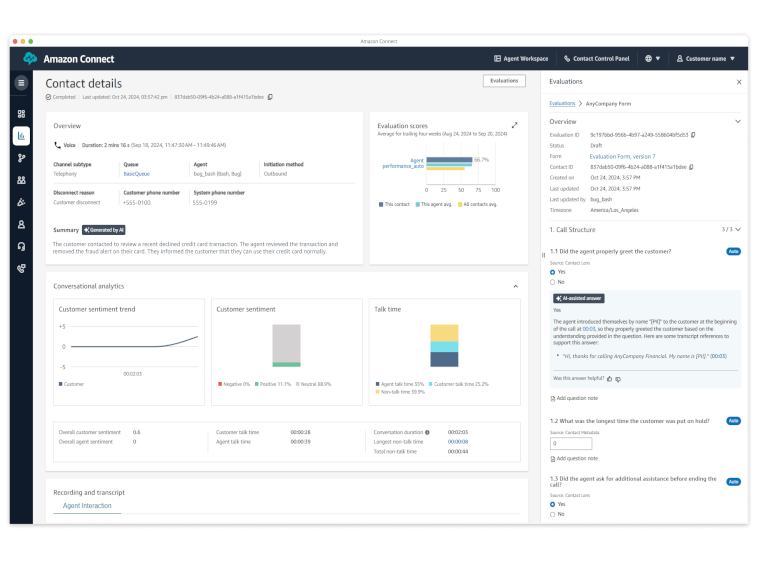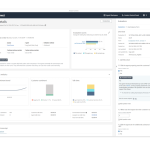Your cart is currently empty!
Amazon Connect Contact Lens: Revolutionizing Contact Center Analytics

Amazon Connect Contact Lens is a transformative feature of Amazon Connect, a cloud-based contact center solution that leverages machine learning (ML) to provide deep insights into customer interactions. By integrating advanced conversational analytics, sentiment analysis, and quality management tools, Contact Lens empowers businesses to enhance customer experiences, improve agent performance, and ensure compliance—all within a user-friendly, no-code platform. This article explores the core capabilities of Contact Lens, its practical applications, and how it is reshaping the contact center landscape.
What is Amazon Connect Contact Lens?
Contact Lens for Amazon Connect is a suite of ML-powered analytics tools designed to analyze voice and chat interactions in real-time and post-interaction. Introduced as a generally available feature in July 2020, it uses natural language processing (NLP), speech-to-text transcription, and generative AI to deliver actionable insights. Unlike traditional contact center analytics, which often rely on manual reviews or limited data points, Contact Lens automates the process, providing a comprehensive view of customer sentiment, conversation trends, and agent performance.
Key features include:
- Real-Time and Post-Contact Transcription: Automatically transcribes voice and chat interactions, enabling supervisors to review conversations without listening to entire recordings.
- Sentiment Analysis: Uses ML algorithms to detect customer sentiment (positive, negative, or neutral) throughout interactions, helping identify emotional trends.
- Sensitive Data Redaction: Automatically identifies and masks sensitive information, such as credit card numbers or personal data, to ensure compliance with privacy regulations.
- Theme Detection: Identifies recurring themes and issues in customer interactions, such as frequent complaints or product mentions, to uncover actionable insights.
- Agent Performance Evaluation: Provides automated scorecards and analytics to assess agent compliance, adherence to scripts, and overall performance.
- Real-Time Alerts and Rules: Triggers alerts based on predefined conditions, such as negative sentiment or specific keywords, allowing supervisors to intervene during live interactions.
How Contact Lens Works
Contact Lens is seamlessly integrated into the Amazon Connect platform, requiring no advanced technical expertise to set up. Administrators can enable it with a few clicks in the Amazon Connect console by selecting the Contact Lens option and configuring a “Set recording and analytics behavior” block in contact flows. Once enabled, it processes voice and chat interactions, generating detailed transcripts, sentiment scores, and metadata stored in Amazon S3 buckets for further analysis.
For example, a contact center can configure Contact Lens to transcribe calls in real-time, analyze sentiment, and flag interactions where a customer mentions terms like “cancel subscription” or exhibits negative sentiment. Supervisors can access these insights through the Amazon Connect console, Contact Control Panel (CCP), or analytics dashboards powered by Amazon QuickSight.
Practical Applications of Contact Lens
1. Enhancing Customer Experience
Contact Lens provides a deeper understanding of customer needs by analyzing sentiment and conversation drivers. For instance, theme detection can reveal why customers are reaching out, such as recurring issues with a product or service. Real-time analytics allow supervisors to intervene when a customer is frustrated, preventing escalations and improving satisfaction. Companies like Intuit have used Contact Lens to analyze over 200 million minutes of interactions, identifying key attributes like product models and contact reasons to enhance customer care.
2. Improving Agent Performance
With automated scorecards and conversational analytics, Contact Lens evaluates agent performance against defined criteria, such as using proper greetings or resolving issues efficiently. Supervisors can create custom rules to detect when agents go off-script or fail to address customer concerns, enabling targeted coaching. For example, a rule might flag interactions where an agent interrupts a customer more than three times, indicating a need for training.
3. Ensuring Compliance and Data Security
Contact Lens automatically redacts sensitive data, such as credit card numbers or addresses, from transcripts and recordings. While not suitable for de-identifying healthcare data under laws like HIPAA, it supports compliance with general data protection regulations. Businesses can control access to redacted and unredacted data through user-defined permission groups, ensuring security and privacy.
4. Streamlining Quality Management
By automating evaluations for 100% of agent interactions, Contact Lens reduces the need for manual reviews, which are often limited to a small sample of calls. Generative AI-powered summaries replace manual note-taking, allowing agents to focus on assisting customers. Supervisors can use dashboards to visualize trends, such as high hold times or negative sentiment, and take data-driven actions to optimize operations.
Real-World Impact
Organizations across industries have leveraged Contact Lens to transform their contact centers. For example, Fujitsu reported a 60% improvement in quality assurance efficiency by using Contact Lens to analyze 100% of customer interactions in real-time, shifting from retrospective to proactive quality management. Accolade, a healthcare benefits provider, used Contact Lens to simplify agent workflows and focus on resolving issues rather than identifying them, analyzing over 15,000 hours of interactions in a single month.
Getting Started with Contact Lens
To enable Contact Lens, businesses need an Amazon Connect instance and can activate the feature through the console. Configuration involves adding a “Set recording and analytics behavior” block to contact flows, selecting options for voice or chat analytics, and enabling features like sentiment analysis or data redaction. Pricing is pay-as-you-go, with charges based on per-minute voice analytics, per-message chat analytics, per-agent evaluations, and per-minute screen recordings. Some features, like the conversational analytics dashboard, are available at no additional cost in supported AWS regions.
For advanced use cases, Contact Lens data can be integrated with Amazon Athena and Amazon QuickSight for custom analytics or streamed to a data lake for long-term trend analysis. Businesses can also connect Contact Lens to external voice systems via a Contact Lens connector for hybrid cloud migrations.
Conclusion: Amazon Connect Contact Lens is a game-changer for contact centers, offering a powerful blend of AI-driven analytics, real-time insights, and automated quality management. By providing a comprehensive view of customer interactions and agent performance, it enables businesses to deliver exceptional customer experiences, optimize operations, and maintain compliance. As companies like Intuit, Fujitsu, and Accolade demonstrate, Contact Lens is not just a tool but a strategic asset for building customer-centric contact centers in today’s competitive landscape.
Useful Link
Help & Support
newsletter
Connecting you to the latest trends and essential information.
Copyright © 2025 LMS 360 Pakistan. All rights reserved.





